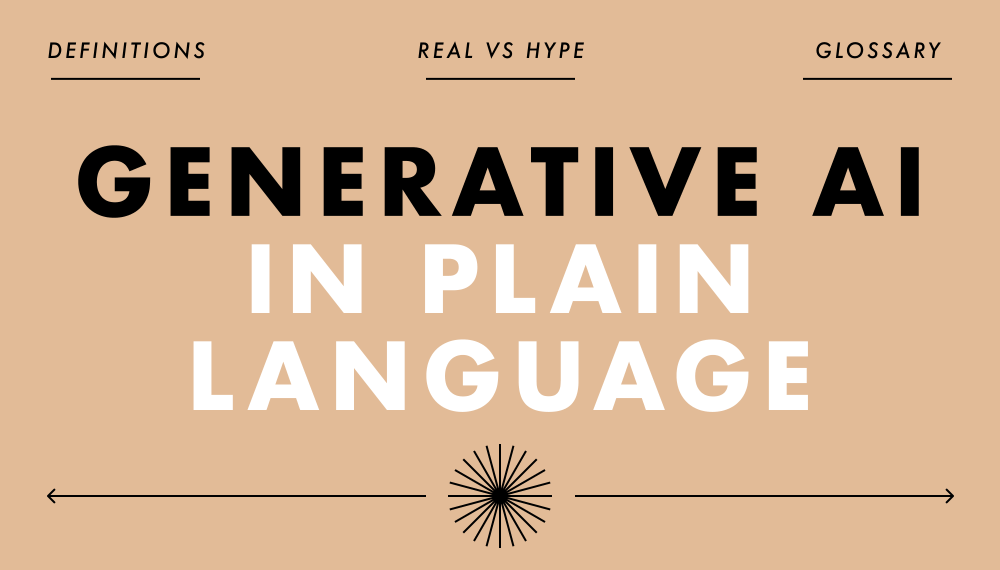AI in action
– 8 min read
Generative AI in plain language: what it is, what’s hype, and what’s real

The buzz around generative AI, and especially OpenAI’s ChatGPT, is noisier than a pack of wild hyenas at a midnight feast. How can you even hear yourself think when AI headlines and hype flood social media feeds every minute?
Consider this your sanity check. We’ll break generative AI down into plain language so you can sound like the expert in the boardroom, Slack group channel, Zoom call, or wherever AI questions come up.
- Generative AI technology uses natural language processing and machine learning to generate new data or content that mimics human-generated content.
- It can be used to generate images, text, audio, and video.
- Generative AI technology can assist talented minds to maximize their abilities, but it can’t replace them.
- Large language models (LLMs) are the ‘brains’ of generative AI writing tools.
- Be thoughtful and purposeful when investing in generative AI tools; look beyond the OpenAI/ChatGPT hype and consider what it takes for a generative AI platform to be enterprise-grade.
- Generative AI is already making its way into the hands of the public and is destined to become a presence in every industry.
Quick definitions: generative AI and large language models
You might have seen some technical concepts thrown around as AI continues to dominate discourse among marketing leaders and execs. Here are the main ones for you to grasp. We’ve also provided a glossary of other AI-related terms at the end of this article.
Generative AI technology uses natural language processing (NLP) and machine learning (ML) to generate new data or content that mimics human-generated content. It’s different from other machine learning technologies because it creates something new, not just recognizing and classifying data like search algorithms do.
This technology can be used to generate:
- Images
- Text
- Audio
- Video
In business, generative AI technology is like a genie that can use existing data to conjure up one-of-a-kind solutions in marketing, design, product development, and beyond. This technology can take mundane, repetitive tasks off your hands so you can create something truly remarkable.

See how companies can put generative AI to work in their business:
Check out The Big Book of AI Use Cases
Large language models (LLMs) are the ‘brains’ of generative AI writing tools. They use machine learning algorithms to recognize the patterns and structure of language and generate new text or natural language.
LLMs are trained on massive sets of data collected from the internet and continue to learn as they encounter new data through fine-tuning and prompting. The quality and type of training data have a major influence on the accuracy and quality of output and the ways you can use it.
For example, Palmyra LLMs are the enterprise-grade foundational models that power the Writer generative AI platform. With a curated, foundational training set of business writing and marketing data, Palmyra LLMs are geared towards use cases across a company, from marketing and sales to operations and product.
The source and potential exposure of training data can impact the level of risk involved with using generative AI for business. If an LLM training set has a training dataset full of toxic, biased, and copyrighted materials, a business risks publishing plagiarized or harmful content. If an LLM for general use adds data from user inputs to its training corpus, a business risks violating privacy and data security regulations. Also, other people and companies might profit from data that should remain the intellectual property of the business.
Find out more about concerns and safeguards in Generative AI risks and countermeasures for businesses.
What’s hype
In late 2022, the masses were introduced to generative AI through unprecedented buzz over OpenAI’s chatbot tool, ChatGPT. Tech giants raced to roll out ChatGPT in consumer software and search engines like Bing, resulting in widely-publicized missteps and misuse.
People have reported getting unhelpful, disturbing and outdated responses from Bing’s ChatGPT chatbot (whose training data is from 2021). Others immediately went the troll route: they tricked ChatGPT into revealing its own proprietary data, violating its own programming on content restrictions, and generating code for malware.
The hype has led many business professionals to believe (mistakenly) that ChatGPT encompasses all generative AI technology. Privacy and security concerns have even prompted enterprise leaders to ban using ChatGPT in their organizations. And with large companies announcing layoffs on a near-daily basis, many knowledge workers fear being replaced by AI counterparts.
But equating all generative AI to ChatGPT ignores the other business applications and opportunities this technology represents. And seeing generative AI as a replacement for human workers obscures the most valuable benefit of this technology: with generative AI, you can scale the best work of your most creative and innovative people.
“Equating all generative AI to ChatGPT ignores the other business applications and opportunities this technology represents.”
What’s real
Simply put: generative AI is no trend — it’s here to stay, and it goes way beyond ChatGPT.
ChatGPT, DALL-E, and OpenAI’s large language models represent only a fraction of a growing landscape of platforms, tools, and LLMs.
Generative AI isn’t an ethereal concept, like the metaverse, but a tangible, proven technology. And it isn’t a tech trend only embraced by techies, like cryptocurrency. Rather, generative AI is already making its way into the hands of the public, in the form of chatbots, writing tools, and art generation apps that are available to everyone.
* (Source: Antler)
The potential of generative AI is so vast that it’s destined to become a presence in every industry, weaving its way into every corner of content creation. As businesses explore and innovate its uses, its possibilities will expand even further.
“ChatGPT, DALL-E, and OpenAI’s large language models represent only a fraction of a growing landscape of AI platforms, tools, and LLMs.”
But enterprise leaders should take heed — generative AI is a technological leap, but it can’t offer the same kind of critical thinking, judgment, innovation, or creative depth that the human mind can provide. Generative AI can assist the most talented minds in your business to maximize their abilities, but it can’t replace them.
Though many current AI writing tools boast of their capacity to serve business objectives, few are truly equipped to meet the needs of the enterprise.
Survey the landscape of business-ready generative AI
You and your stakeholders need to be thoughtful and purposeful when investing in generative AI tools. Talk through the requirements and expectations your organization has for introducing new technology.
Look beyond the OpenAI/ChatGPT hype: get familiar with other major players in the emerging generative AI industry.
Consider what makes an enterprise-grade generative AI platform and how different tools compare for business use.
Also, don’t explore this strange new landscape alone – connect with fellow AI-curious marketing leaders and discover creative ways to use this amazing technology to tackle your biggest challenges. Join the ActiveVoice Slack community for content leaders.
Bonus glossary: AI terminology
Here’s a quick, simple glossary of key terms you’ll need to know when it comes to AI tools.
Artificial Intelligence (AI)
A general term for anything that allows computers to carry out human-like behaviors.
Machine Learning (ML)
A sub-type of AI where machines don’t need to be explicitly programmed. They use algorithms to identify and learn patterns in data, apply that learning, and improve themselves to make better and better decisions.
Deep learning (DL)
Where computers learn in a way that mimics the human brain. In deep learning, machines build layers of knowledge that are increasingly complex.
Algorithm
A detailed set of instructions a computer follows to carry out a task or solve a problem.
Generative AI
Artificial intelligence that uses existing text, code, images, video, etc, to synthesize new content.
Training
The process of feeding data to a model so that it can identify patterns, and recognize those patterns in future analyses.
Model
A program you train to recognize patterns in a data set.
Large Language Model (LLM)
A model trained on a massive quantity of text data for performing natural language tasks, like answering questions, generating text, summarizing documents, and more. For example, Palmyra Large from Writer is an LLM that’s trained on about 20TB of data.
Natural Language Processing (NLP)
A method of teaching computers to understand the way humans use language. It’s NLP that allows Google to make sense of what you type into the search bar.
Natural Language Understanding (NLU)
A branch of NLP where computers figure out what human-generated text means.
Natural Language Generation (NLG)
A branch of NLP where computers generate human-like text.






